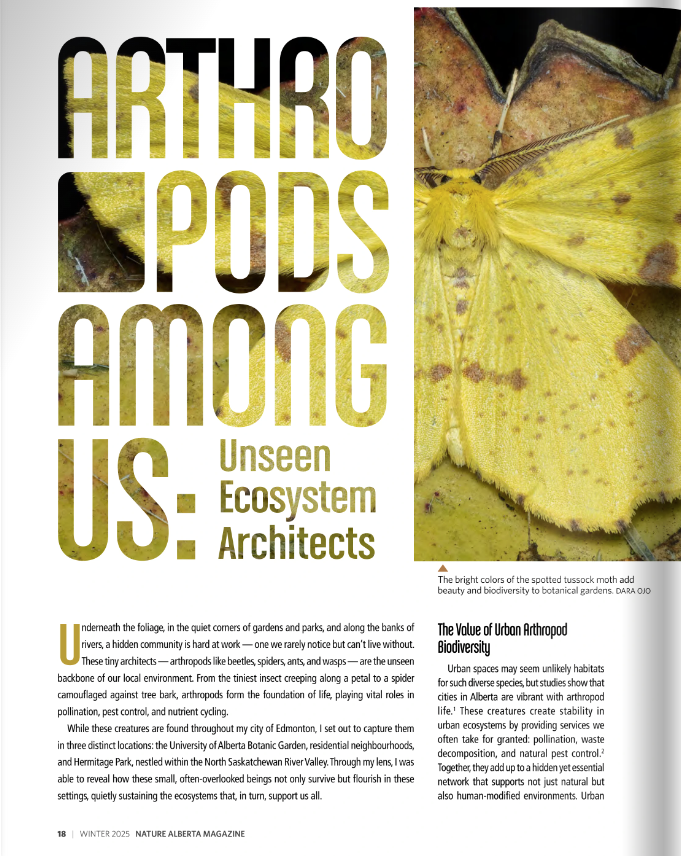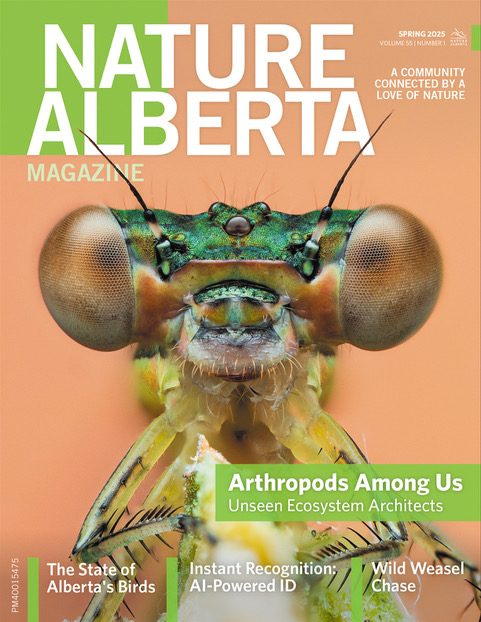Arthropods Among Us: Unseen Ecosystem Architects
16 April 2025
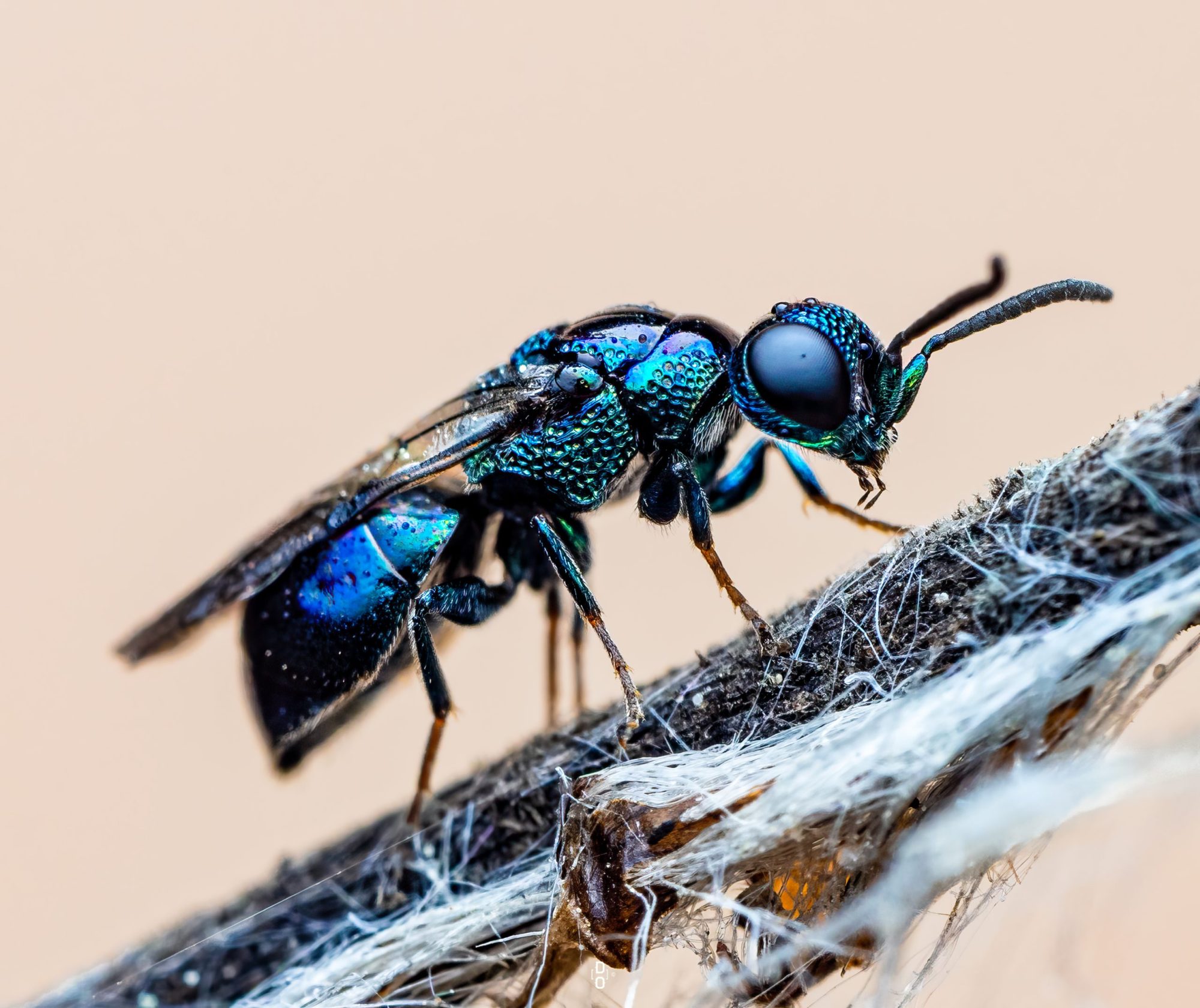
By DARA OJO
Beneath the foliage, in the quiet corners of gardens and parks, and along the banks of rivers, a hidden community is hard at work — one we rarely notice but can’t live without. These tiny architects — arthropods like beetles, spiders, ants, and wasps — are the unseen backbone of our local environment. From the tiniest insect creeping along a petal, to a spider camouflaged against the bark, arthropods form the foundation of life, playing vital roles in pollination, pest control, and nutrient cycling.
While these creatures are found throughout my city of Edmonton, I set out to capture them in three distinct locations: the University of Alberta Botanic Garden, residential neighbourhoods, and Hermitage Park, nestled within the North Saskatchewan River Valley. Through my lens, I was able to reveal how these small, often-overlooked beings not only survive but flourish in these settings, quietly sustaining the ecosystems that, in turn, support us all.
The Value of Urban Arthropod Biodiversity
Urban spaces may seem unlikely habitats for such diverse species, but studies show that cities in Alberta are vibrant with arthropod life.1 These creatures create stability in urban ecosystems by providing services we often take for granted: pollination, waste decomposition, and natural pest control.2 Together, they add up to a hidden yet essential network that supports not just natural but also human-modified environments. Urban biodiversity studies reveal how cities can foster niches for these adaptable creatures, even as urbanization and climate change reshape their habitats.3 By understanding and appreciating these tiny yet powerful contributors, we see just how resilient and valuable they are to our world. Each habitat offers a unique glimpse into the ways arthropods live and interact with their environments.
Outdoor Botanical Gardens
I explored my local University of Alberta Botanic Garden, where there’s a subtle hum of life in every corner. From bees to hoverflies, pollinators flit between vibrant blooms, sustaining the delicate ecosystem of this cultivated space. Botanical gardens in urban settings, like this one, significantly support pollinator populations by offering reliable food sources year-round. For arthropods, these carefully cultivated beds provide a blend of native and exotic plants, creating a complex mosaic of food and shelter that nurtures biodiversity. As I observed hoverflies darting from petal to petal, I realized how these gardens act as urban sanctuaries, sustaining delicate yet vital lives.
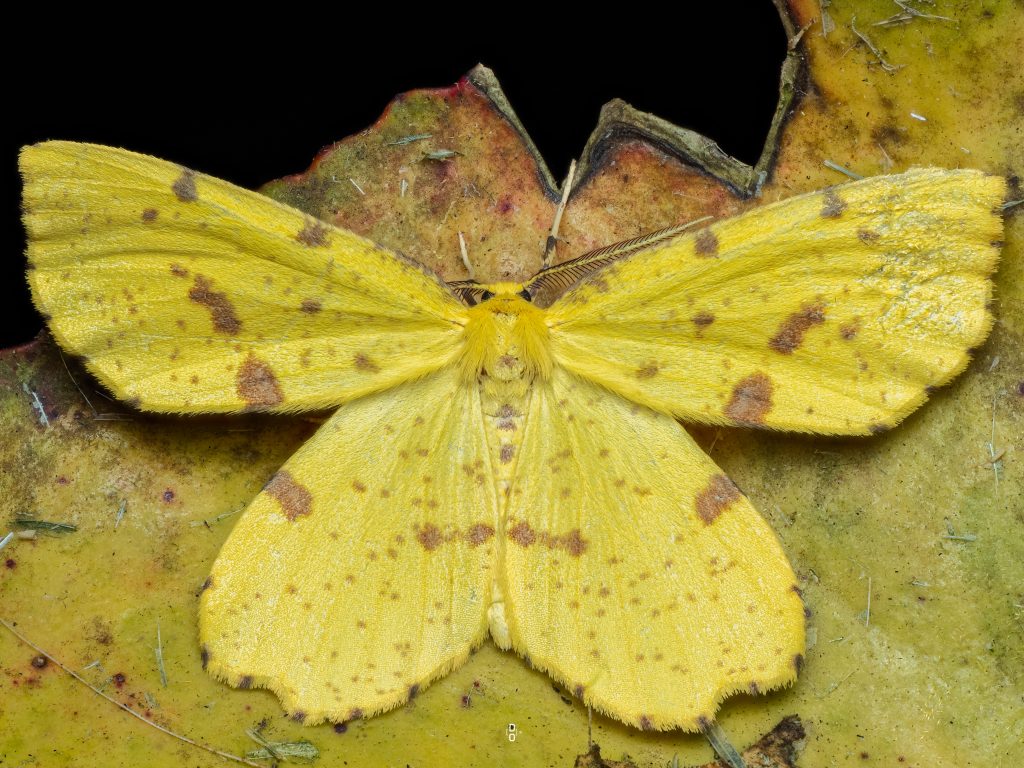
The bright colors of the spotted tussock moth add beauty and biodiversity to botanical gardens. DARA OJO
Urban Neighbourhoods
Arthropods have learned to coexist with us, adapting to the human-modified landscapes of our neighborhoods. From flowerbeds to well-tended lawns, every green space is a potential microhabitat. Here, bees, ants, and beetles quietly carry on, adding texture and resilience to the ecosystem right outside our doors. Research shows that urban gardens, especially those with native plants and minimal pesticide use, play a critical role in supporting biodiversity.4 While capturing these creatures on camera in urban spaces, I saw how these quiet workers thrive beside us, maintaining the delicate balance of our shared environment.
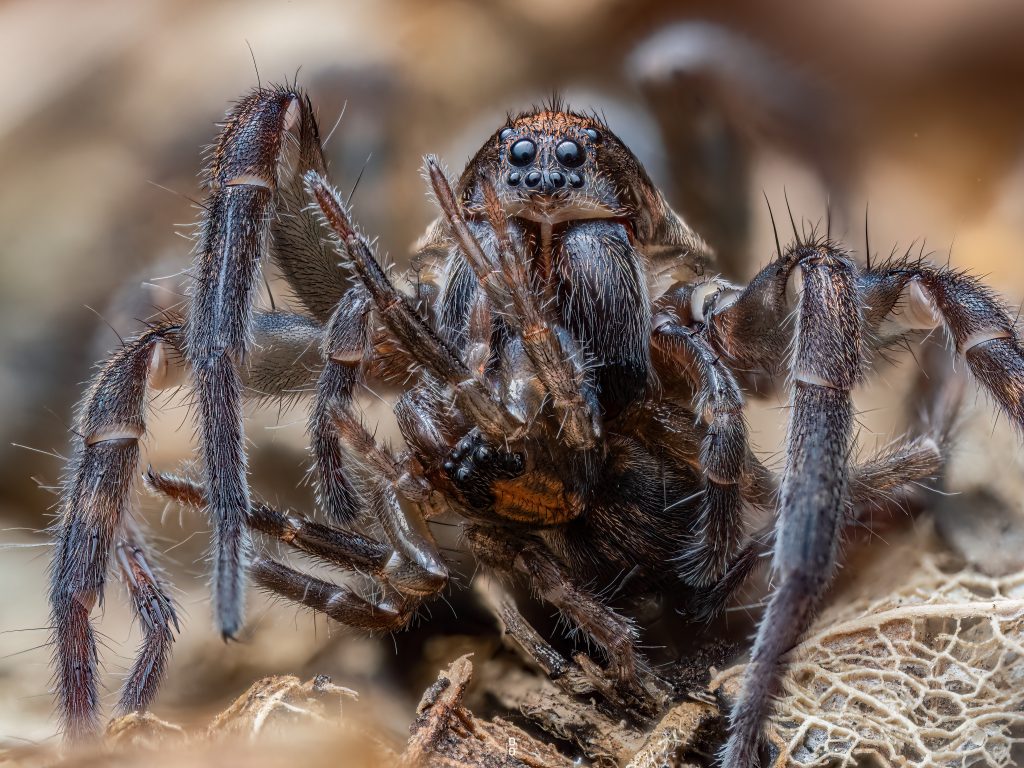
A rare sight: one wolf spider preying on another. This behavior highlights complex survival dynamics. DARA OJO
River Valley Park
With its lush vegetation and proximity to water, the river valley park offers refuge for various arthropods, such as dragonflies skimming the river or spiders spinning webs between tree branches. Riparian zones are vital for urban biodiversity, offering a blend of aquatic and terrestrial habitats that support complex food webs. Arthropods control pest insect populations and pollinate riverside vegetation, essential functions that reverberate throughout the ecosystem. In this natural setting, I observed the wild side of a city, where nature’s smallest predators and pollinators thrive amidst the backdrop of a river valley.
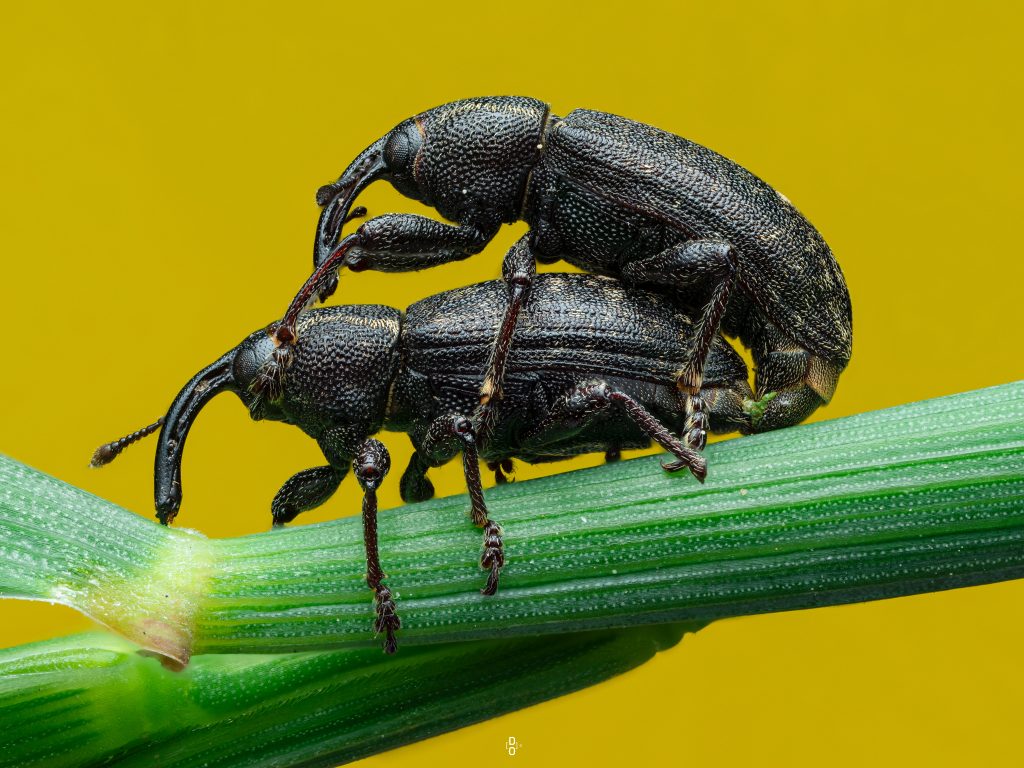
Two weevils engage in a mating ritual, captured in a delicate moment of connection. These tiny beetles, often overlooked, play a role in biodiversity, reminding us of the hidden lives that thrive even in the heart of a city. DARA OJO
Ecological Contributions and Broader Implications
Arthropods play critical roles in ecosystems, connecting species across various trophic levels and fostering ecological stability in surprising ways. Their contributions are not just fascinating, they are essential in several ways.
Pollination and food web support: Without arthropods like hoverflies and bees, pollination would decline, reducing the plants’ abilities to produce fruits and seeds. This would ripple through the food web, affecting organisms that rely on these plants and their fruits for sustenance. These pollinators ensure not just the survival of plants but also the species that depend on them.
Soil health and nutrient cycling: Arthropods such as ants and beetles are nature’s decomposers, breaking down organic matter into nutrients that enrich the soil. This ongoing recycling keeps soil healthy and productive, a critical factor in the growth of plants that serve as the foundation of all land-based ecosystems.
Seasonal adaptations: Arthropods are masters of survival, showcasing remarkable adaptations to Alberta’s challenging winter climate. Some produce antifreeze proteins that enable them to endure freezing temperatures, while others enter a state of dormancy called diapause. These adaptations are key to their resilience, allowing them to maintain their roles in the ecosystem even in the harsh grip of winter.
In these ways, arthropods support the ecosystems we depend on and the green spaces that make cities livable.
Conservation, Citizen Science, and Community Engagement
Embracing a city’s diverse arthropod residents both benefits ecological health and enhances public awareness. The importance of conservation and citizen science initiatives cannot be overstated in sustaining these small but significant creatures.
Urban green spaces, such as outdoor botanic gardens and city parks, are adopting conservation practices that reduce pesticide use and enhance arthropod habitats. Research underscores how even small conservation measures can lead to significant biodiversity gains, supporting the delicate balance of urban ecosystems.4
Citizen science activities, such as capturing images and documenting sightings of arthropods around town, invites residents to contribute to scientific understanding of urban biodiversity.5 These community-based projects provide essential data and foster ecological literacy, empowering the public to connect with nature while supporting scientific research.6
Creating insect-friendly habitats calls for small adjustments in our own backyards, such as planting native flowers or letting parts of our gardens grow wild. These adjustments make a big difference for arthropods. Studies indicate that urban gardens designed with native plants not only support biodiversity but also act as “stepping stones” for species movement across cities, helping arthropods survive in fragmented urban environments.7
Urban landscapes may seem familiar, but a closer look reveals an ecosystem buzzing with life. Arthropods, small as they are, play large roles in sustaining the greenery and biodiversity we cherish. As I explored, I was reminded of how interconnected our lives are with these tiny titans. By appreciating and protecting their habitats, we contribute to an ecological legacy that benefits all residents — no matter how many legs they have. It’s a call to see our world through a new lens, one that values the unseen and cherishes the small but mighty.
REFERENCES
- Baldock, K.C.R. et al. (2019). A systems approach reveals urban pollinator hotspots and conservation opportunities. Nature Ecology & Evolution, 3, 363-373. https://doi.org/10.1038/s41559-018-0769-y
- Matteson, K.C., J.S. Ascher and G.A. Langellotto (2008). Bee Richness and Abundance in New York City Urban Gardens. Annals of the Entomological Society of America, 101(1), 140-150. https://doi.org/10.1603/0013-8746
- Aronson, M.F.J. et al. (2014). A global analysis of the impacts of urbanization on bird and plant diversity reveals key anthropogenic drivers. Proceedings of the Royal Society B: Biological Sciences, 281(1780), 20133330. https://doi.org/10.1098/rspb.2013.3330
- Goddard, M.A., A.J. Dougill and T.G. Benton (2010). Scaling up from gardens: biodiversity conservation in urban environments. Trends in Ecology & Evolution, 25(2), 90-98. https://doi.org/10.1016/j.tree.2009.07.016
- Silvertown, J. (2009). A new dawn for citizen science. Trends in Ecology & Evolution, 24(9), 467-471. https://doi.org/10.1016/j.tree.2009.03.017
- Bonney, R. et al. (2009). Citizen Science: A Developing Tool for Expanding Science Knowledge and Scientific Literacy. BioScience, 59(11), 977-984. https://doi.org/10.1525/bio.2009.59.11.9
- Hall, D.M. et al. (2017). The city as a refuge for insect pollinators. Conservation Biology, 31(1), 24-29. https://doi.org/10.1111/cobi.12840
Dara Ojo is an internationally recognized macro photographer and conservation advocate whose work has been showcased on platforms such as the United Nations Conference on Biodiversity and Adobe Lightroom. Through exhibitions, media features, and community engagement, he highlights the beauty and ecological importance of arthropods to inspire conservation efforts.
Read the Original Article for this Post
For a richer reading experience, view this article in the professionally designed online magazine with all images and graphs in place.
This article originally ran in the Spring 2025 issue of Nature Alberta Magazine (Vol. 55 | No. 1).

